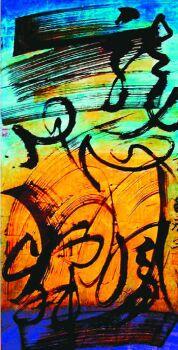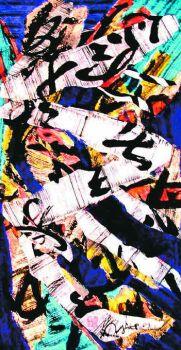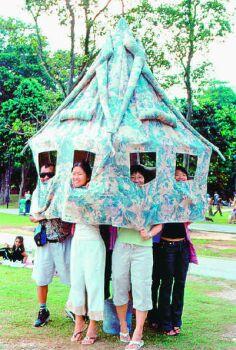A major exhibition of art in Singapore based on Chinese calligraphy highlights the ways in which language, genres and images flow freely across time and space.

Photography by HO YUE WENG
Images compliments of HO HO YING and TEO ENG SENG
Excerpt from Frontline, India's National Magazine from the publishers of THE HINDU, URL: http://www.flonnet.com
A major exhibition of art in Singapore
based on Chinese calligraphy highlights the ways in which language, genres and
images flow freely across time and space.

Ho Ho Ying, "Flourishing Strokes", Pigment & Ink, 140 x 74 cm

Ho Ho Ying, "Restructure IV", Pigment & Ink, 140 x 74 cm.

Teo Eng Seng, "Together", Mixed Media, 300h x 140L x 140B

Teo Eng Seng, "Water, Bell, River, Sea", Fabric, Bronze, 600 x 200 cm
Ho Ho Ying and Teo Eng Seng employ Chinese calligraphy only to exhort us to `See It. Feel It. Love It', as the title of their recent joint art exhibition in Singapore goes. The exhibition was organized by the MASS - Modern Art Society, Singapore - between October and November 2003 at the Telok Kurau Studios Gallery.
They do not expect their viewers
to be literate in Chinese. In a conversation with the reviewer during the show,
Teo Eng Seng admitted that he was illiterate in Chinese calligraphy unlike Ho Ho
Ying who was well versed in it.
In any event, their works transform the calligraphic strokes, at an apparent
level, into representational and non-representational images, in a typical
modernist vein. They deploy the predominantly gestural characteristics of
calligraphy to reinforce an arbitrary attribute of their brushwork.
At a deeper level, however, the external characteristics of calligraphy do not
merely reinforce the flatness of the picture space in the ways in which such
aesthetic options were favored during the 1950s and 1960s much beyond Europe.
The works eschew, with remarkable freshness, further explorations into the known
aesthetic elements of, say, surface and textures.
In other words, Ho Ying and Eng Seng appropriate calligraphy in such a way that
the resulting images become visual subtexts. The subversive act of invoking a
language only to undermine its textual content is a direct witness to this. The
very title "See it. Feel it. Love it." foregrounds, for instance, these distinct
expectations from the viewers. In turn, the show shifts attention from the
readability of the artworks to a more effective participatory role of the
viewers.
An installation piece by Teo Eng Seng, "Together" in the show is directly to the
point.. It literally appropriates the viewers as well as the gallery space as
its material. The work transforms the gallery space in such a way that the
viewers become an indispensable part of the work with their limbs enacting parts
of the calligraphic gesture in the work.
It proposes a mock serious distance that separates the viewers from a fictional
horizon that is located away from them within the gallery. Teo Eng Seng, in a
number of his two-dimensional works included in the show, constantly addresses
such fictional spaces by employing layers upon layers of his chosen material. He
employs hand made paper, through a process that he has named paperdyesculp, for
creating multiple layers of surfaces.
Ho Ho Ying, on the other hand, merges the surface with the calligraphic
characters in his compositions. The formal characteristics of the text and the
image are integrated to reinforce the unique visual subtexts he proposes. His
works seem to privilege sensory experiences, at the outset, by undermining
analytical interpretations. However, they actually pay tribute to the alliance
between image and text in such a way that neither of them is reduced to its
apparent meaning.
The surface in "Restructure IV" (Figure 4), for instance, is reinforced through
multiple colors that interlace and vibrate in such a way that neither of them
can be reduced to a simplistic one-dimensional form or meaning. A baffling maze
of calligraphic strokes overlap and define the composition through a marked
stress on expressionist gestures. As Tao Eng Seng pointed out in a conversation
with the reviewer during the show, calligraphy is calligraphy if we do not
understand it. It is, in fact, a reminder of the complex issue that we do not
get what we see in a language, visual or otherwise. It is an ever-expanding
process suggesting the ways in which surface and depth constantly collaborate.
Ho Ho Ying and Teo Eng Seng's invocation of calligraphy and its related
dimensions inevitably lead to the vexed issues of tradition especially as they
appropriate the other conventional genre of painting. Their unique works
hightlight with exceptional playfulness and wit the ways in which language,
genres and images flow freely across time and space. Moreover, what results as a
hybrid identity is but a potential beginning, considering the privileged
position that the artists accord to their viewers